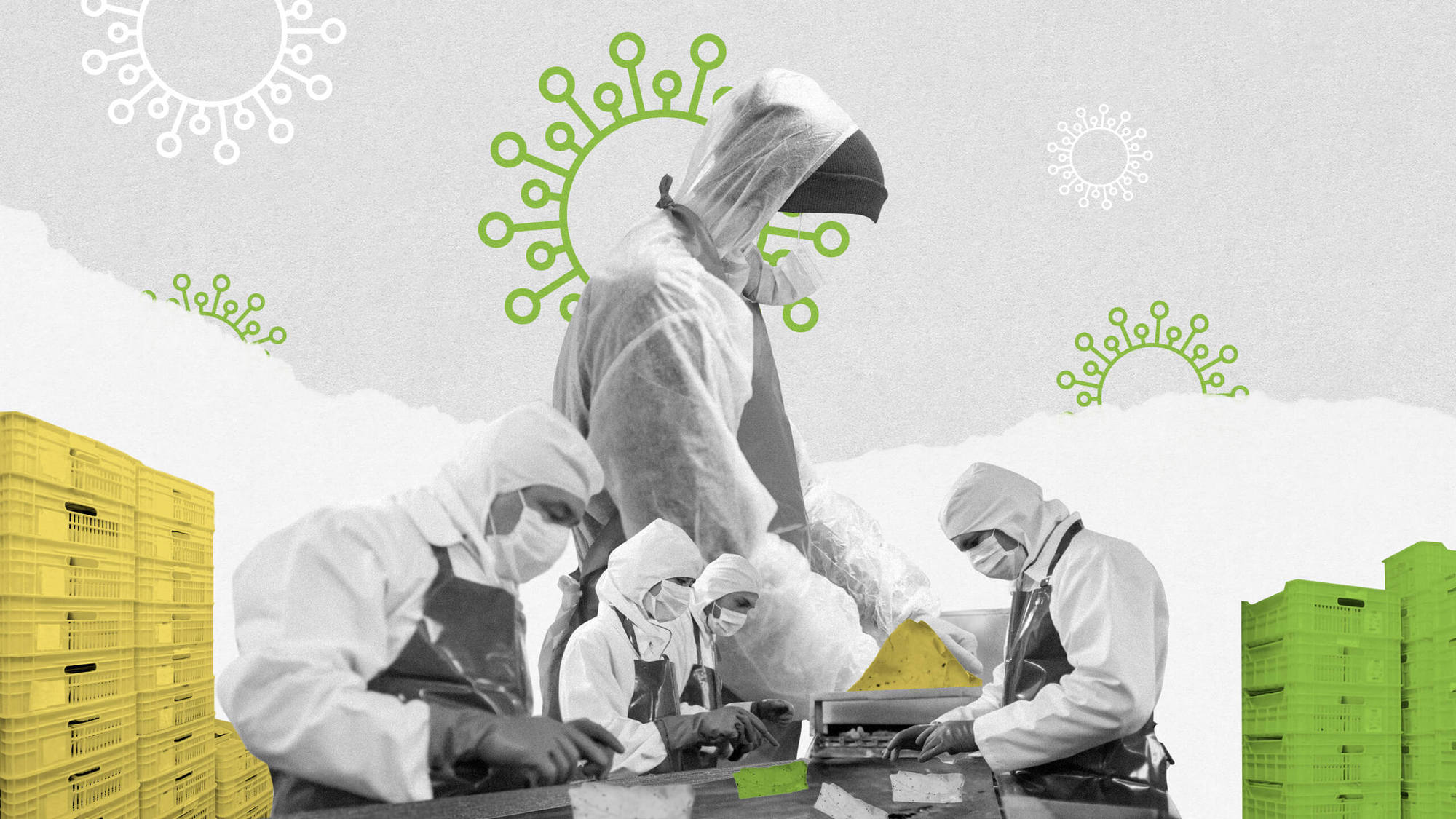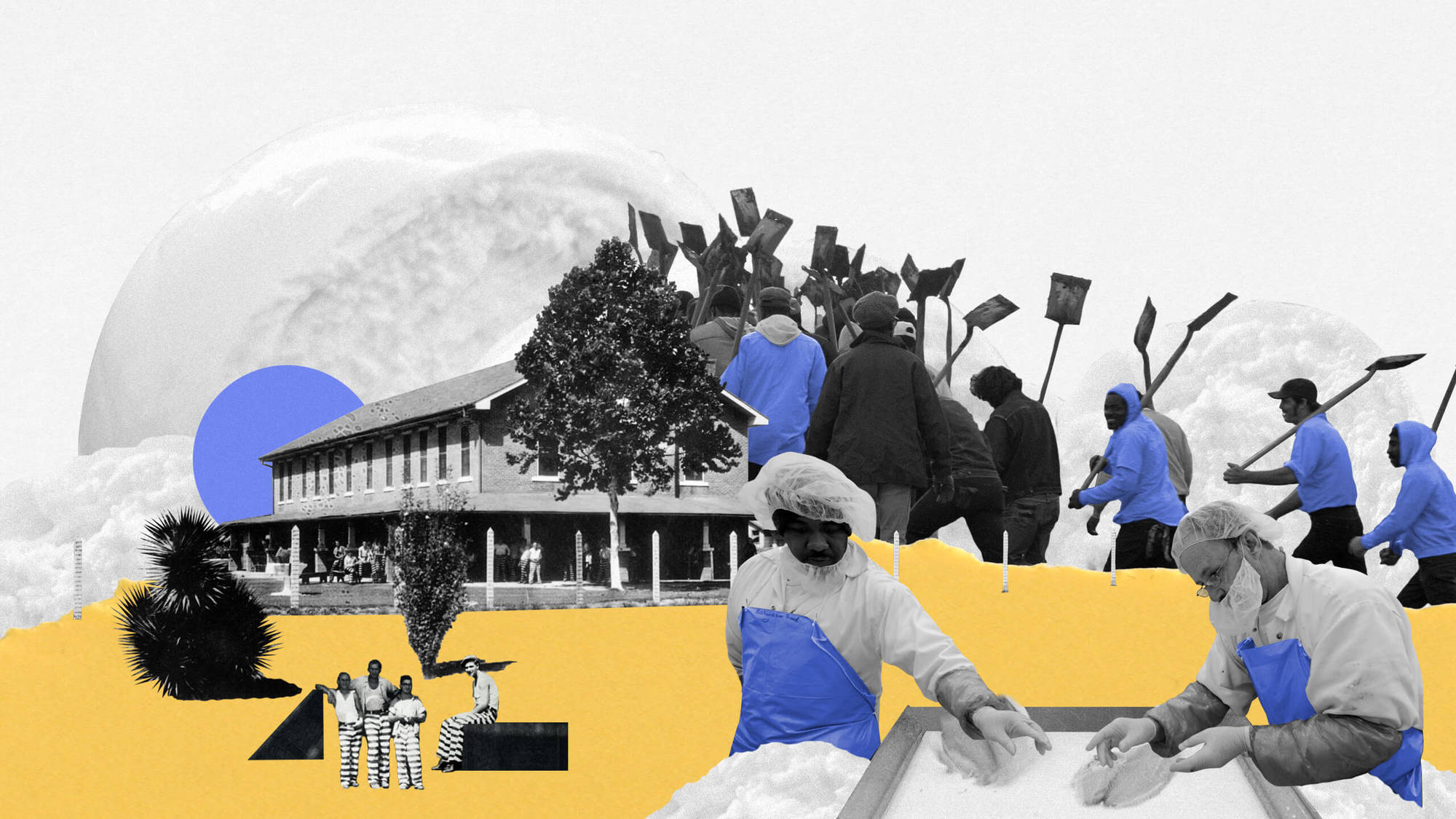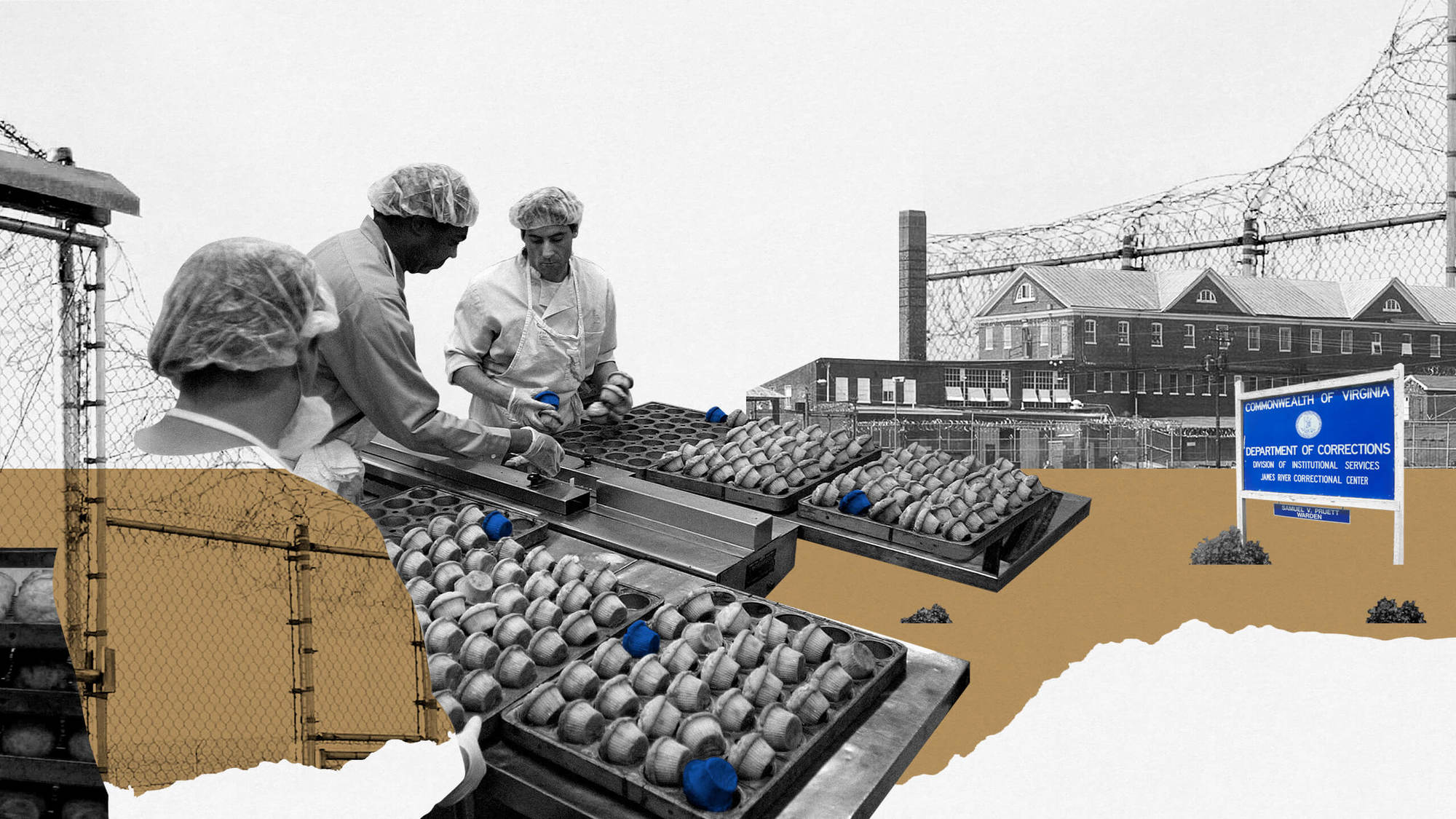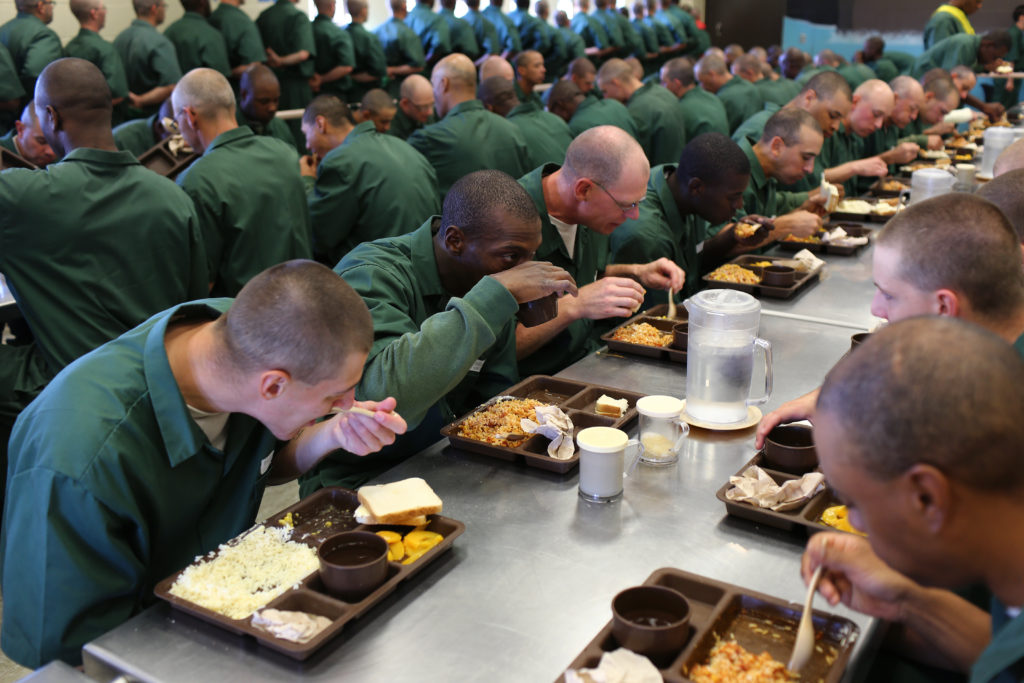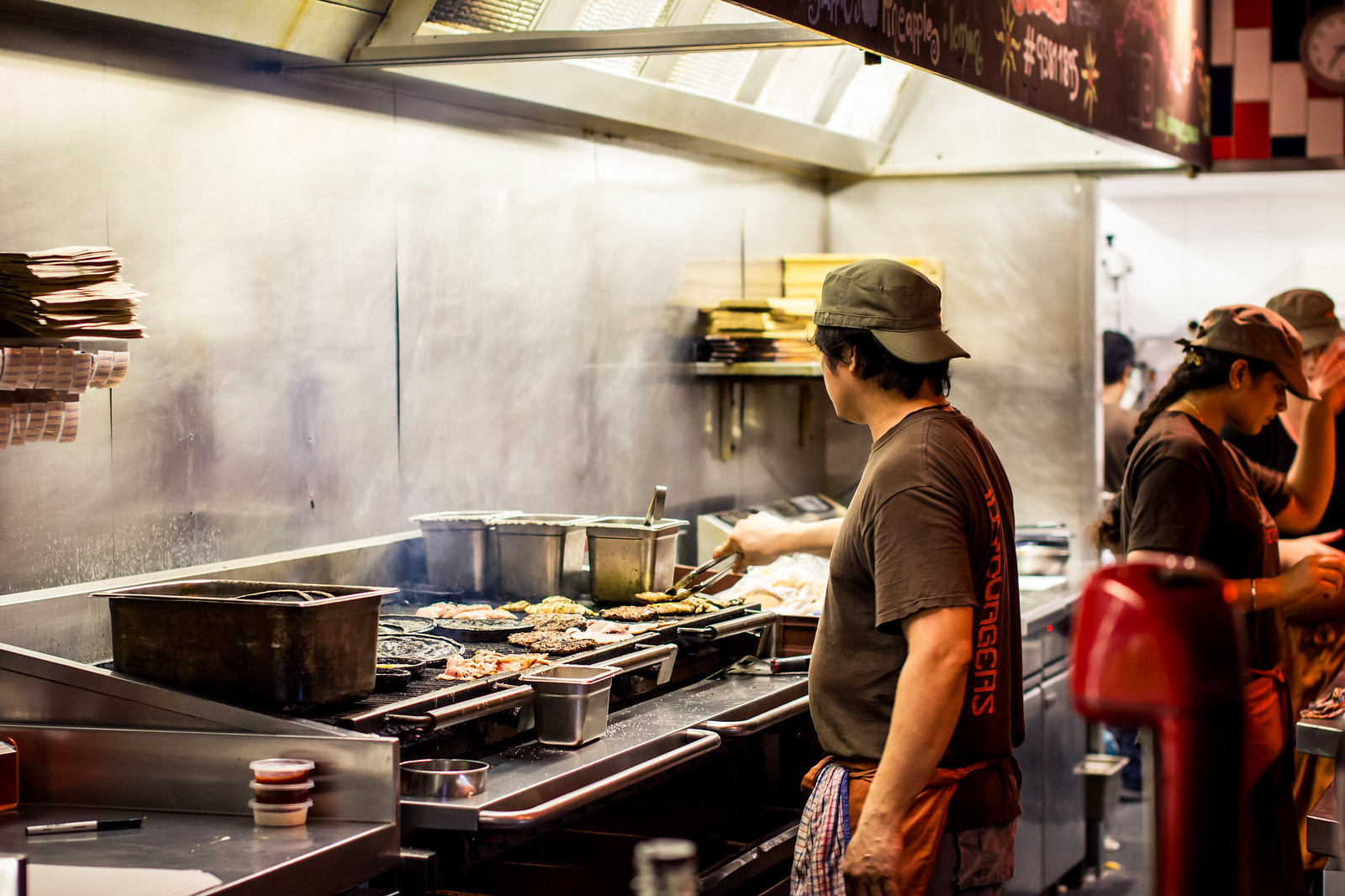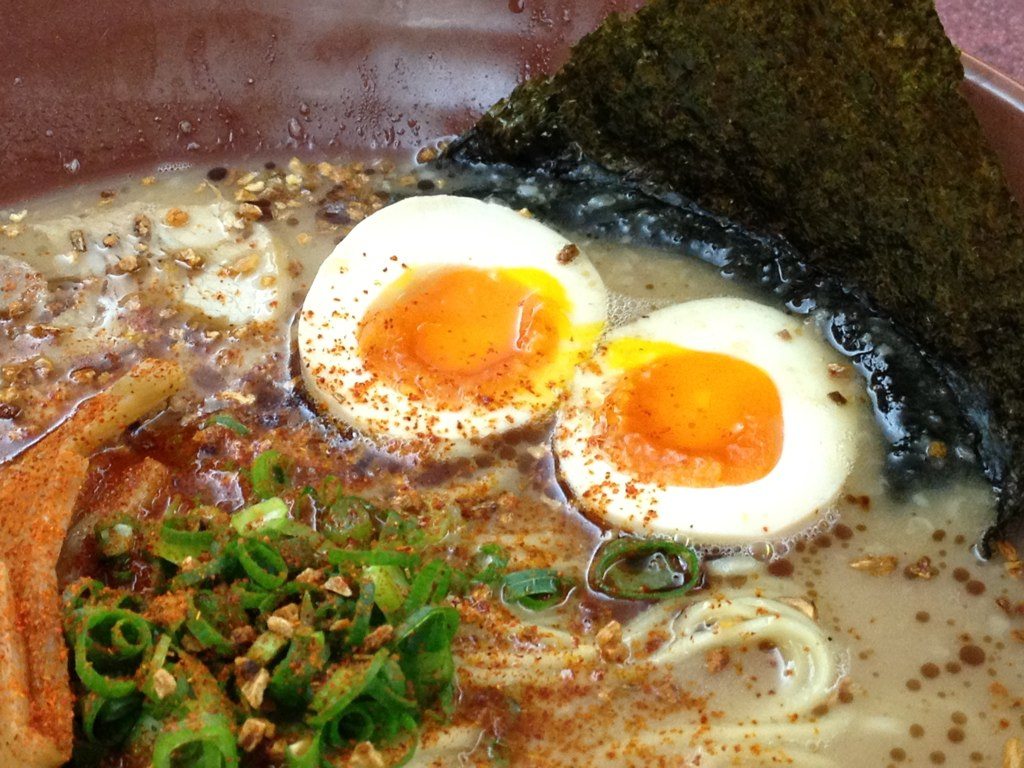Working conditions have amplified debates about pay and protections for prison jobs.
In April 2020, Ricardo DeLeon worked in production in the food factory at the Coyote Ridge Corrections Center in Connell, Washington, when one of his co-workers showed up to work feeling ill, he said.
DeLeon, an incarcerated man earning $1.70 per hour, said he was responsible for overseeing a team of about 20 people who worked on an assembly line, filling and rolling burritos as they inched along a conveyor belt before being dropped into a freezer. Those burritos were sent to other correctional facilities, hospitals, and food banks. “Breakfast burritos, dinner burritos—all product cooked fresh,” he said.
He said he’d been talking with other co-workers since the pandemic began to try to persuade management to implement stronger Covid-19 precautions: It was hot in the factory and people weren’t always wearing their masks, and hand sanitizer was scarce. Social distancing measures were not being followed. DeLeon hoped management would relax production quotas and isolate people who might have been exposed to coronavirus. “Talking with management is kind of difficult,” he said. “There was no communication—just, ‘Keep it going.’”
“Management didn’t know what to do, you know, the upper management didn’t know what to do. They were just so struck by … all these people that started falling ill.”
During a shift in April, one of the guys on DeLeon’s line came to work feeling a little ill. His cellmate had contracted Covid-19. And despite quarantining and receiving a test, DeLeon said the man came to work the next day. “We were at work for four, five days before anything seriously took place,” DeLeon said. The Washington Department of Corrections later shut down the food factory altogether, citing a decline in revenue. At time of publication, 414 cases had been confirmed at Coyote Ridge, and two people had died.
DeLeon said he did eventually contract the virus, though he was asymptomatic and received three inconclusive tests before receiving a positive test. He thinks the Department of Corrections could have implemented tighter safety measures to prevent the spread of the virus. “They could’ve done way better. You know, they were lost, they had so many—so many things going on, you know what I mean?” he said. “Management didn’t know what to do, you know, the upper management didn’t know what to do. They were just so struck by … all these people that started falling ill.”
In an email, the Washington Department of Corrections (WDOC) said that Coyote Ridge followed “science-based protocols” to prevent the spread of Covid-19 and that incarcerated workers were and are required to pass a health screening before going to work. WDOC also said that the Department of Agriculture (USDA) conducted daily inspections to ensure the safety of staff, incarcerated workers, and the food supply chain. It provided The Counter with a list of protocols implemented in the food factory that included temperature checks, use of personal protective equipment, and surface sanitation. The department also said it provided additional moisturizing lotion for incarcerated workers to prevent their hands from drying out.
However, the agency did acknowledge that social distancing was not possible on assembly work lines.
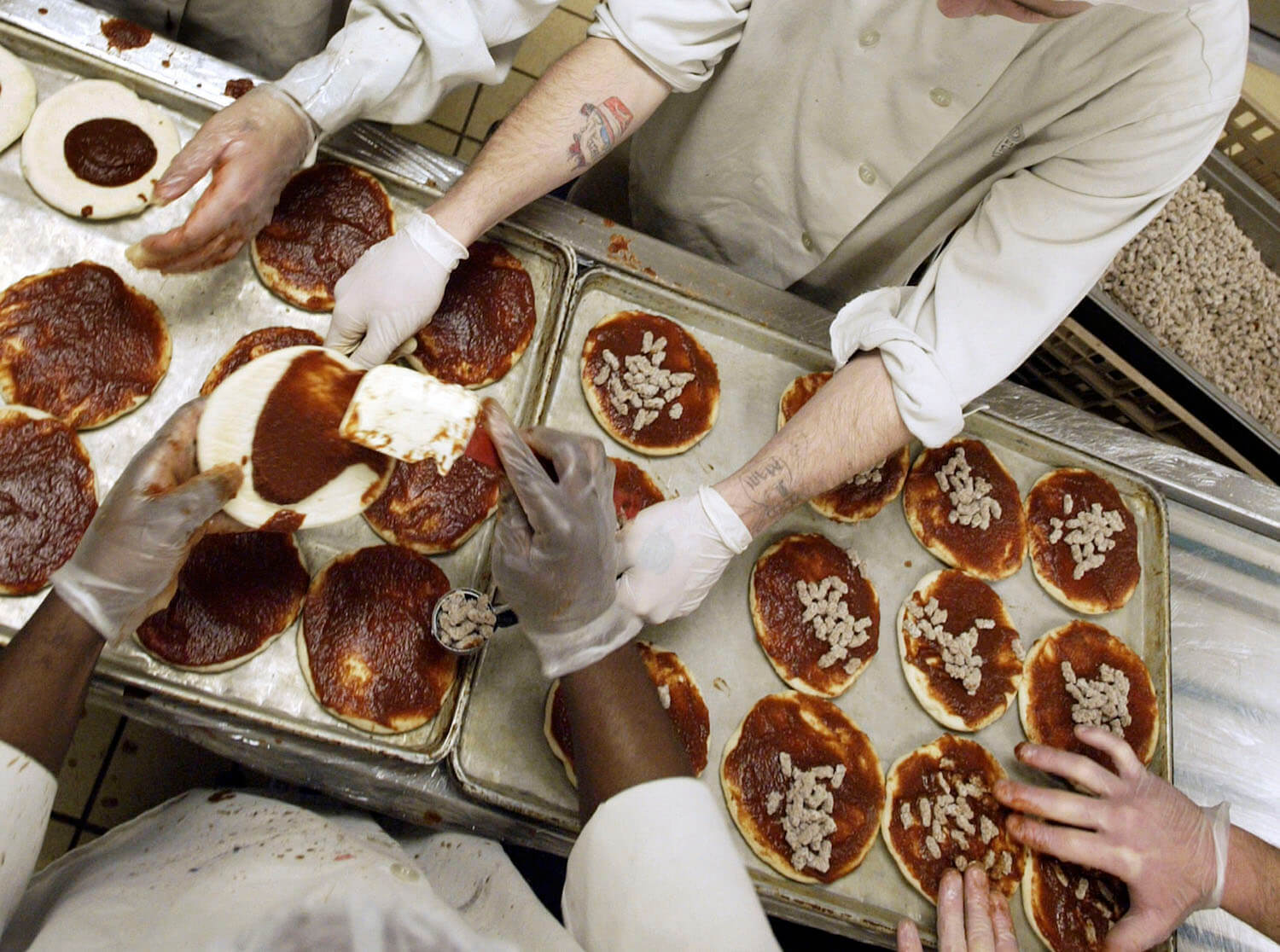
People in prison have labored throughout the pandemic in jobs that are considered “essential” elsewhere. Yet unlike many essential workers across the country, they lack basic job protections like sick pay and federal workplace safety oversight, not to mention hazard pay or minimum wage.
Jeff T. Green/Getty Images
Washington isn’t the only state that kept prison food factories running after Covid-19 began to spread last year. In 2020, incarcerated people working under the auspices of the California Prison Industry Authority (CALPIA) baked cookies, roasted almonds, processed peanut butter, and packaged snickerdoodles later sold to various state hospitals. Incarcerated workers told the Los Angeles Times they felt infection control at work was “questionable” yet worried that refusing to work would result in disciplinary actions that would prevent their release.
People in prison have labored throughout the pandemic in jobs that are considered “essential” elsewhere. Yet unlike many essential workers across the country, they lack basic job protections like sick pay and federal workplace safety oversight, not to mention hazard pay or minimum wage. Indeed, their incarcerated status has meant that many have no choice but to work in places they fear will make them sick or face retaliation. Many have continued to work even as they’ve seen other privileges curtailed in the name of disease prevention.
“In a bigger picture, this tells you that the system itself has certain financial obligations that it needs to carry out—whether those financial obligations are selling goods to other state institutions or producing goods for the institution itself in order for it to be viable. Those are the priorities,” said James Kilgore, formerly incarcerated activist and research scholar at the University of Illinois Urbana-Champaign.
“The welfare of people inside is really marginalized.”
—
The notion that mass incarceration persists because it produces widespread cheap labor has largely been debunked by advocacy groups like the Prison Policy Initiative: The people working in the industries that sell products to state institutions and private companies make up a small fraction of the total number of incarcerated people. In reality, much of the work that happens in prison sustains the prison itself through food prep, laundry, and janitorial services.
Still, the pandemic has proven that small yet influential prison industries can have an outsized impact on the quality of life for incarcerated people: In Washington and California, prison factories remained operational, even as incarcerated people worried that their operations were contributing to the virus’ spread.
As we reported in part one of this series, researchers have identified at least 650 U.S. correctional institutions that have some sort of food processing, landscaping, or farming operation. About half of states run some sort of farm or animal agriculture operation. People employed in state prisons earn anywhere from nothing to $5.15 per hour, averaging $0.14 to $1.14, according to a 2017 study by the Prison Policy Initiative. In federal institutions and many states, incarcerated people cannot refuse to work.
“Let’s be honest: Most of the stuff you are going to do in a prison job … most of it people kind of already knew.”
The sociologist Erin Hatton identifies three aspects of jobs in prison that combine to make the work function as punishment: poor pay, lack of autonomy, and mistreatment at work.
If the pandemic has shown a harsh light on lack of autonomy (DeLeon wasn’t able to secure stronger virus-prevention measures on the job) and mistreatment at work (he was exposed to the virus through a co-worker whose cellmate had already contracted Covid-19), the question of fair pay has been debated for far longer. Prison administrators tend to rationalize incarcerated labor by insisting the jobs provide important training and rehabilitation. Yet the currently and formerly incarcerated people, academics, and activists we spoke to for this story largely disputed those arguments, even if some saw other kinds of value in the work.
Chandra Bozelko, columnist and author of the blog “Prison Diaries,” did not want to work in the kitchen at the women’s prison in Connecticut, where she was incarcerated until March 2014. “I was drafted,” she said, and she wasn’t exaggerating: The state of Connecticut requires incarcerated people convicted of a crime to work, if asked (people who are in prison awaiting trial are not subject to the same requirements). Her shift started at 3:30 in the morning.
But Bozelko grew to enjoy her work. Soon after she was released, she heard about the protest of Whole Foods tilapia and goat cheese that led to the company dropping Colorado Correctional Industries as a supplier. “I was literally sick over it,” she said, adding that she would have been upset if attention from activists had prompted the disappearance of her job. “I don’t know what I would have done. I was paid to go to my job, I got to walk in fresh air. I got to eat different food—like I got to have a salad rather than a gross fish patty. So what it did was save my life.”
“I think one of the most obvious injustices in our prison system is that you have people who are working certain jobs, and then they come out of the prison system and they can’t get those same jobs on the outside.”
Still, Bozelko disputed the notion, often advanced by corrections departments, that her work stirring 200-gallon vats of “casserole meals” provided meaningful job training. “Let’s be honest: Most of the stuff you are going to do in a prison job … most of it people kind of already knew,” she said.
Sociologist Josh Sbicca and feminist geographer and political ecologist Carrie Chennault of Colorado State University, who co-direct the Prison Agriculture Lab, found that prisons and correctional industries cited vocational training as one of the primary reasons why they maintain farms and food manufacturing facilities in prisons. There’s not much evidence (or, apparently, expectation) that any skills gained in these jobs result in food industry work upon release, Sbicca said. Some states do offer training certificates for specific skills, like pesticide application, but data on whether people use those certificates later in life is scarce. “What that suggests to me is this notion that agriculture is a means to work in prison,” not a ticket to a good job outside. “It’s a means to actually feed prison populations. It’s also a means to make mass incarceration more affordable,” said Sbicca.
Unemployment statistics for formerly incarcerated people further undermine the job training and rehabilitation argument. A 2018 study by the Prison Policy Initiative found that formerly incarcerated people were unemployed at a rate of 27 percent, a number roughly five times the national average. The rate climbed even higher in the first year or two after release. This so-called “prison penalty” in unemployment is highest for Black women, at 44 percent, and Black men, at 35 percent.
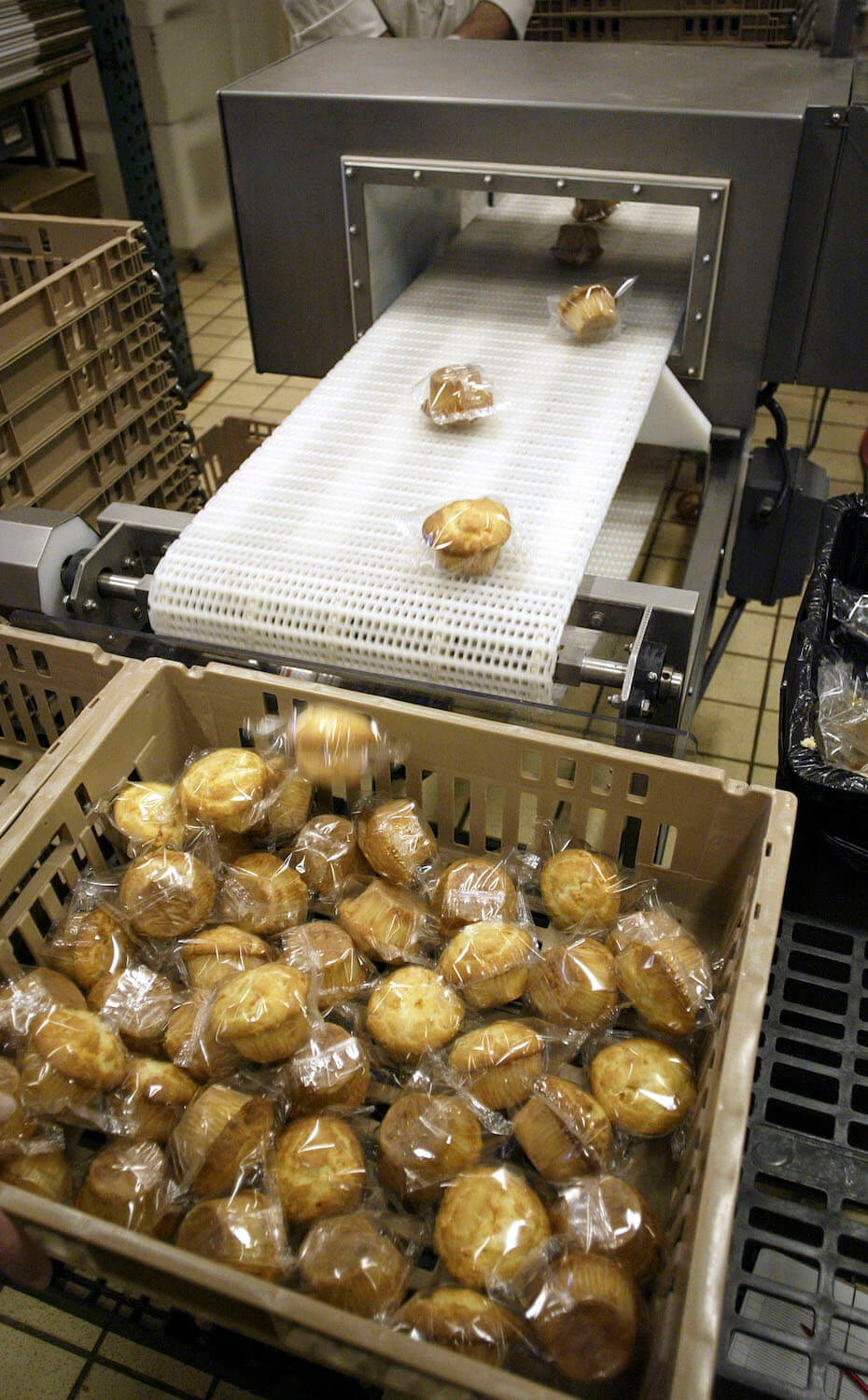
Jeff T. Green/Getty Images
Freshly baked muffins are run through a metal detector, before they leave the Airway Heights Corrections Center factory in Airway Heights, Washington.
“I think one of the most obvious injustices in our prison system is that you have people who are working certain jobs, and then they come out of the prison system and they can’t get those same jobs on the outside,” said Wanda Bertram, spokesperson for the Prison Policy Initiative.
Luke Williams worked in bakery jobs in various prisons in Virginia for several years. He was incarcerated at age 18 and released about a year and a half ago, at age 44. Right after he was released, he used job training certificates earned in prison to find work in construction and delivering furniture. But Williams’ years of baking experience had little bearing on his job search post-release, though he says he learned about responsibility while working in prison (he had not had a regular job before he was incarcerated as a teenager). He now works as a delivery driver.
In some ways, Williams’ trajectory upon release is exactly what prison administrators say they hope to achieve: He was able to use some of the skills and certificates earned in prison to find jobs immediately upon release.
Still, Williams said he believes the work he did in prison should have been compensated better than the $0.45 an hour he earned at the top of the pay scale in the kitchen. “I think you should at least get minimum wage. Because, if they were working on the street, they’d be getting minimum wage. And I think they take advantage of the vulnerability of guys because a lot of guys don’t have families,” he said, referring to people serving life sentences. Also, commissary food was incredibly expensive, so meager wages didn’t go very far. “Guys in there are basically being used like slaves,” he said.
“I think you should at least get minimum wage. Because, if they were working on the street, they’d be getting minimum wage. And I think they take advantage of the vulnerability of guys because a lot of guys don’t have families. Guys in there are basically being used like slaves.”
“I do think it would be great if people earned a decent wage—even a minimum wage,” Bozelko said. “But if that were the cost of, say, we can only have two jobs versus 20, I would say give the 20. And I understand that puts me in what I consider a morally untenable position, which is that people aren’t making minimum wage.”
Legislators in California may be edging toward a change in the way prison labor is compensated in the state. Early in 2020, the state Senate passed a resolution known as SCR 69 affirming its support for raising wages for working prisoners in California, where pay falls between eight cents and $1 per hour. SCR 69 was not passed in the assembly and, even if signed by the governor, it would signal intent rather than concrete change.
The bill lays out reasons for a raise: More than half of inmates’ wages is set aside for restitution, and low wages mean low payments to those affected by crime. Parents who entered prison owe an average $10,543 in child support, an amount that would take over a decade to pay back at $0.37 per hour. And formerly incarcerated people often face intense financial distress upon leaving prison: Only 55 percent have any reported earnings in the first year after release, and many leave prison with “criminal justice debt” like court and lawyer fees and electronic monitoring fees. All of these factors depress the economic circumstances and opportunities of incarcerated people and their families (add to that the high cost of phone calls, emails, and toiletries in prison, and saving is exceedingly difficult).
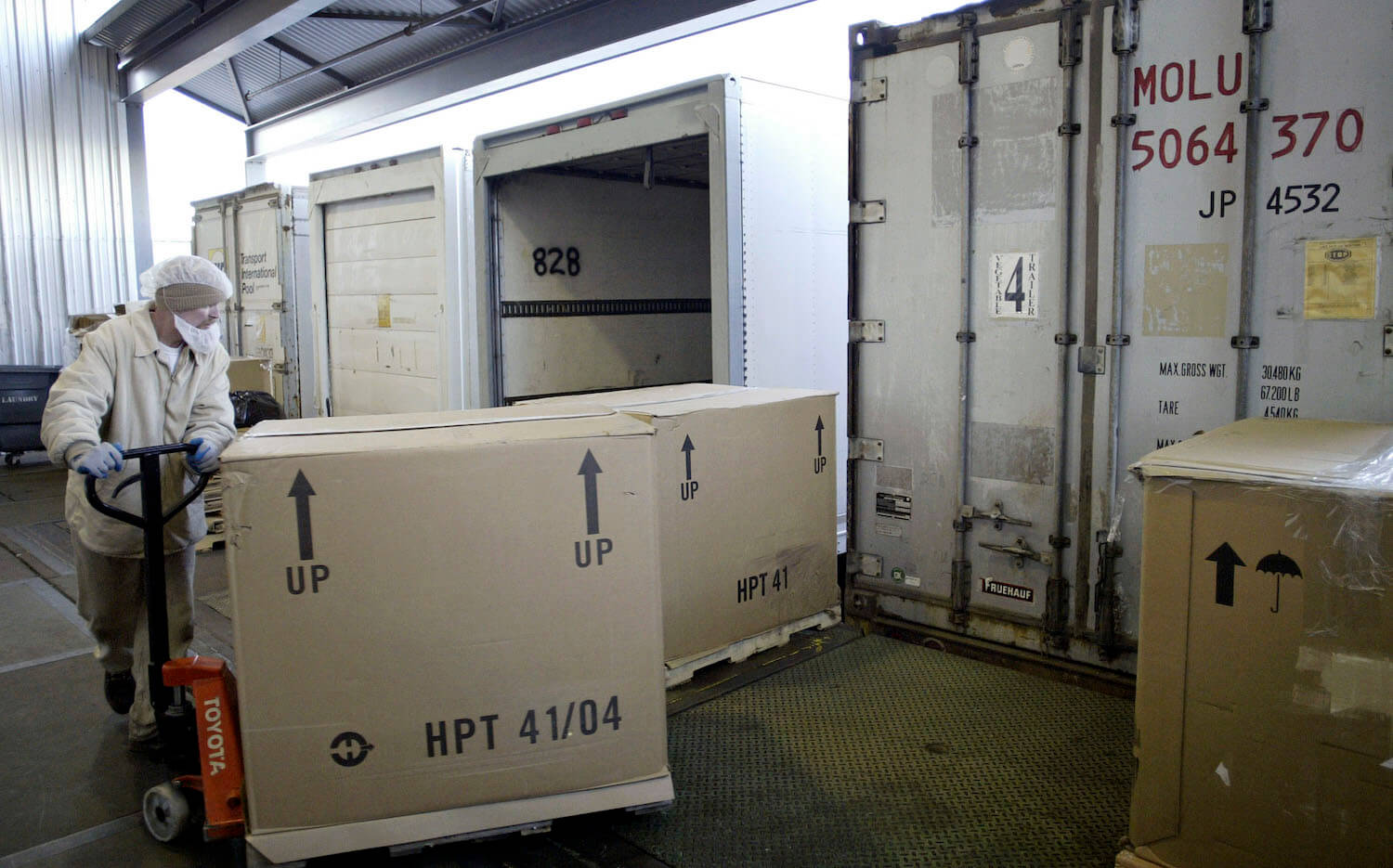
The pandemic has proven that small yet influential prison industries can have an outsized impact on the quality of life for incarcerated people: In Washington and California, prison factories remained operational, even as incarcerated people worried that their operations were contributing to the virus’ spread.
Jeff T. Green/Getty Images
“Being in prison is a very expensive experience,” Bertram said. “Not just for the incarcerated person, but for their family who’s supporting them.” Meanwhile, CALPIA, the state prison industry, generates $60 million each year in gross profit.
Minimum wages for prison jobs may improve the lives of incarcerated people, but some advocates worry that focusing on wages misses a broader conversation about the criminal justice system. “If you give me a job where I can make a dollar and a quarter an hour producing something in a factory, I’ll take it. I’ll go there because it’s going to give me some money, it’s going to take some pressure off my family in terms of providing support for me, et cetera. It’s the best I can get,” said James Kilgore.
“That’s a perfectly logical argument when we look at the individual level. When we look at the systemic level, improving the working conditions for people in prison means putting more money into prisons. I’m opposed to that on a structural level,” he added.
“This is a political project, mass incarceration. It’s a Democratic Party project. It’s a Republican Party project. It’s a neoliberal project. It’s a political project. There wouldn’t be a single prison built if we didn’t have politicians voting the money to build them.”
The “monster” problem of mass incarceration, Kilgore argued, requires a monster solution. It’s not enough to offer incarcerated workers personal protective equipment, thicker mattresses, or better wages; it’s not enough to dismantle private prisons in hopes of minimizing corporate profits. “This is a political project, mass incarceration. It’s a Democratic Party project. It’s a Republican Party project. It’s a neoliberal project. It’s a political project. There wouldn’t be a single prison built if we didn’t have politicians voting the money to build them,” he said.
For now, having lost his job when the food factory closed, DeLeon is working in the kitchen at Coyote Ridge, making less than half of what the factory paid. “Losing the job and the position, that was hurtful, but I did think they made the right decision” in closing the factory, he said.
“I wasn’t the type of person that [the closure most] hurt,” he said, adding that some of his peers with longer sentences felt more like “working is life.”
“In the long run, my family was still there.”
